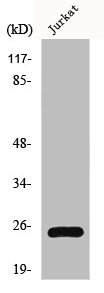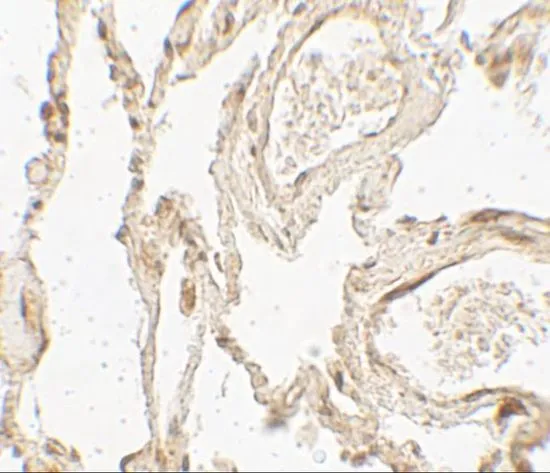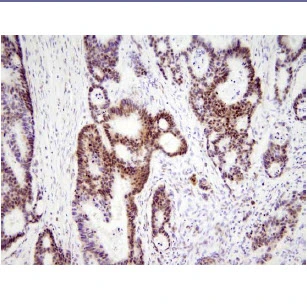HMGB1 antibody
GTX101277
ApplicationsImmunoFluorescence, Western Blot, ImmunoCytoChemistry, ImmunoHistoChemistry, ImmunoHistoChemistry Paraffin
Product group Antibodies
TargetHMGB1
Overview
- SupplierGeneTex
- Product NameHMGB1 antibody
- Delivery Days Customer9
- Application Supplier NoteWB: 1:500-1:3000. ICC/IF: 1:100-1:1000. IHC-P: 1:100-1:1000. *Optimal dilutions/concentrations should be determined by the researcher.Not tested in other applications.
- ApplicationsImmunoFluorescence, Western Blot, ImmunoCytoChemistry, ImmunoHistoChemistry, ImmunoHistoChemistry Paraffin
- CertificationResearch Use Only
- ClonalityPolyclonal
- Concentration0.43 mg/ml
- ConjugateUnconjugated
- Gene ID3146
- Target nameHMGB1
- Target descriptionhigh mobility group box 1
- Target synonymsHMG-1, HMG1, HMG3, SBP-1, high mobility group protein B1, Amphoterin, Sulfoglucuronyl carbohydrate binding protein, high-mobility group (nonhistone chromosomal) protein 1
- HostRabbit
- IsotypeIgG
- Protein IDP09429
- Protein NameHigh mobility group protein B1
- Scientific DescriptionDNA binding proteins that associates with chromatin and has the ability to bend DNA. Binds preferentially single-stranded DNA. Involved in V(D)J recombination by acting as a cofactor of the RAG complex. Acts by stimulating cleavage and RAG protein binding at the 23 bp spacer of conserved recombination signal sequences (RSS). Heparin-binding protein that has a role in the extension of neurite-type cytoplasmic processes in developing cells.
- Storage Instruction-20°C or -80°C,2°C to 8°C
- UNSPSC12352203
References
- Wen J, Yin P, Su Y, et al. Knockdown of HMGB1 inhibits the crosstalk between oral squamous cell carcinoma cells and tumor-associated macrophages. Int Immunopharmacol. 2023,119:110259. doi: 10.1016/j.intimp.2023.110259Read this paper
- Li Z, Wang-Heaton H, Cartwright BM, et al. ATR prevents Ca(2+) overload-induced necrotic cell death through phosphorylation-mediated inactivation of PARP1 without DNA damage signaling. FASEB J. 2021,35(5):e21373. doi: 10.1096/fj.202001636RRRRead this paper
- Sixto-López Y, Rosales-Hernández MC, Contis-Montes de Oca A, et al. N-(2'-Hydroxyphenyl)-2-Propylpentanamide (HO-AAVPA) Inhibits HDAC1 and Increases the Translocation of HMGB1 Levels in Human Cervical Cancer Cells. Int J Mol Sci. 2020,21(16). doi: 10.3390/ijms21165873Read this paper
- Kanno Y, Shu E, Niwa H, et al. Alternatively activated macrophages are associated with the α2AP production that occurs with the development of dermal fibrosis : The role of alternatively activated macrophages on the development of fibrosis. Arthritis Res Ther. 2020,22(1):76. doi: 10.1186/s13075-020-02159-2Read this paper
- Huang L, Jian Z, Gao Y, et al. RPN2 promotes metastasis of hepatocellular carcinoma cell and inhibits autophagy via STAT3 and NF-κB pathways. Aging (Albany NY). 2019,11(17):6674-6690. doi: 10.18632/aging.102167Read this paper
- Contis-Montes de Oca A, Rodarte-Valle E, Rosales-Hernández MC, et al. N-(2'-Hydroxyphenyl)-2-propylpentanamide (OH-VPA), a histone deacetylase inhibitor, induces the release of nuclear HMGB1 and modifies ROS levels in HeLa cells. Oncotarget. 2018,9(70):33368-33381. doi: 10.18632/oncotarget.26077Read this paper
- Dörsam B, Seiwert N, Foersch S, et al. PARP-1 protects against colorectal tumor induction, but promotes inflammation-driven colorectal tumor progression. Proc Natl Acad Sci U S A. 2018,115(17):E4061-E4070. doi: 10.1073/pnas.1712345115Read this paper
- Coleman LG Jr, Zou J, Qin L, et al. HMGB1/IL-1β complexes regulate neuroimmune responses in alcoholism. Brain Behav Immun. 2018,72:61-77. doi: 10.1016/j.bbi.2017.10.027Read this paper
- Masola V, Zaza G, Bellin G, et al. Heparanase regulates the M1 polarization of renal macrophages and their crosstalk with renal epithelial tubular cells after ischemia/reperfusion injury. FASEB J. 2018,32(2):742-756. doi: 10.1096/fj.201700597RRead this paper
- Liu PL, Liu WL, Chang JM, et al. MicroRNA-200c inhibits epithelial-mesenchymal transition, invasion, and migration of lung cancer by targeting HMGB1. PLoS One. 2017,12(7):e0180844. doi: 10.1371/journal.pone.0180844Read this paper




![HMGB1 antibody [Giby-1-4]](https://www.genetex.com/upload/website/prouct_img/normal/GTX33926/GTX33926_20160831_Structure_w_23060800_655.webp)